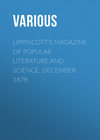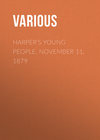Kitabı oku: «Birds and Nature, Vol. 12 No. 5 [December 1902]», sayfa 2
AN AMATEUR CIRCUS
A True Story
We were not like ordinary children – in fact as I look back on our younger days it comes to me ever more strongly how very unlike we were. There was Harvey, my older brother, who never did anything that other children did and was always perpetrating some most extraordinary thing which certainly no one else ever would have thought of. However, in spite of this trait, or possibly in consequence of it, he afterwards became famous. But that is neither here nor there – we were all what the neighbors termed “unexpected,” if they were kindly disposed, otherwise it was some word to the same effect though less mild.
It was always a great blessing to us and one which we received with thankful hearts, that our father was a man of science, and his line of work made him the recipient of a varied assortment of animals which he would bring home alive and keep until he was ready to work upon them. It was only natural that we children should become fond of these creatures and beg that they might be spared the eternal sleep and left to us to play with. This was often granted.
So it happened at one time that we were the proud possessors of twenty-five different kinds of birds, animals and reptiles and the envy of all the children for blocks around.
It is so long now since the time of which I write that I may not be able to recall them all, but I give them as I remember them and by their rank – for they had rank as well as names, the highest in intelligence always going first – as they did at our funerals; for when any one of the little colony died we would give it a burial in accordance with its station in life.
First beside the grave would stand Rex, my beautiful dog, whose knowledge was so great it seemed almost human; then would come “Daisy,” Harvey’s little Mexican pony; then “Lorita,” the parrot, whose intelligence was really remarkable; after her came “Jackie,” the monkey, and so on down. The cat, the crow, with his one white tail feather; then the smaller birds; two love-birds, a brown thrush, a blue jay and the canary. Three baby foxes followed the birds and then came the squirrels, gray, red, and flying squirrels; next to these stood the rabbits, a dozen or more of all kinds and colors: Belgian hares, pure yellows, angoras, whites and blacks, they came, a motley crew. The weasel and muskrat were next, and now the reptiles were beginning; the turtles, a hellbender and the snakes; black snakes, garter snakes, green snakes, a puffing adder and last of all came two boa constrictors.
I have reserved a special place for my own dear, stupid, little hedge hog, Billy. It used to grieve me to always see poor Billy straggling off at the end of the animals – ahead of the reptiles, to be sure – a pathetic little figure of stupidity, but Harvey insisted he deserved no better place. Possibly it was because he seemed so lonely and despised by the others, but at any rate, Billy was an especial pet of mine, and in order to disprove Harvey’s statement that, “it was impossible to teach it anything,” I spent much time and pains on Billy, and at last succeeded in teaching him to utter a little grunt when I would scratch his back and ask, “Want your supper, Billy?” But the thing that made me the proudest was when he at last could go up stairs. It was nearly three years before Billy could accomplish the entire flight, and even then it was a long and weary pilgrimage; but the patience I had expended upon him had not been in vain. It was comical to watch his efforts – the little short forelegs trying to reach up to the next stair, where he knew a lump of sugar would be his reward.
But I am digressing. One day father and mother having gone out of town to a funeral, we children were left to ourselves. It was an opportunity not to be neglected, and our brains were at work trying to plan some new game, when Harvey arrived in our midst triumphantly waving a huge sheet of paper – a “bill-poster” he called it – upon which, in large letters, were the headlines, “Grand Circus,” and then followed an account of the animals that would take part and the tricks they would perform. Harvey assigned us our posts – he himself being ring-master, by right of his seniority and having thought of the game. Alice was the “fat lady,” while I, Paul, being the youngest, was nothing but a “feeder of animals” and tent shifter.
Under the direction of the Circus Master we assembled the menagerie in cages, or loose as the case might be, up in Mother’s bed-room. It took a good deal of time to get them all together. Polly was of a roving disposition and had to be coaxed down from the top of a tall tree, where she had perched, a square or so away; the crow was up on the roof; the rabbits and hares were scampering all over the garden – in fact, nothing but the caged animals seemed to be at hand. But the task was finally accomplished and all were ranged around the room waiting for Harvey, who had disappeared mysteriously some little time before.
Suddenly there was a most terrific clatter and noise, coming ever nearer and nearer. We looked at each other open-mouthed with surprise, when, with a flourish of lariat and a wild Indian war-whoop, that rose above the deafening noise, in dashed Harvey upon “Daisy,” a triumphant figure – having accomplished the difficult feat of making the pony carry him up stairs. He dismounted with a jump. “Ladies and Gentlemen,” he began, “the first act on the programme will be by this wonderful horse – Daisy, down on your haunches!” The lariat swept the air in true ring-master fashion, and Daisy obediently sat back on her haunches.
“Shake hands, Daisy.”
The hoof came up – but here Rex interfered. He realized the pony had no business there and felt the responsibility which rested upon him. Good dog that he was, he started toward her, barking sharply, as though to say, “Go away – you know you have no business here.”
Then, as if his bark had been a signal, all the other animals lifted up their voices, and for a while it was pandemonium let loose – screeches from Polly, calls of “Mamma” from the crow (which it could say as plainly as any parrot, though its tongue had never been slit), grunts and squeals mingled in utter confusion. In the midst of it all who should walk in but Uncle Charles.
Now, we all knew that Uncle was not disposed to pass over lightly even the least of our offenses, and what he would say, and what was more, do now, we dared not think. But Harvey was equal to the occasion. He knew Uncle’s weak point, and went towards him nonchalantly swinging the snakes who stuck out their heads as they swayed back and forth.
Now, to us children the snakes were just as nice and pretty as any of the animals, but they were quite the opposite to Uncle Charles. The great, writhing things, swaying to and fro as they twisted in Harvey’s hands and stuck out their heads, in which the eyes dully gleamed, filled him with loathing and disgust, not unmixed with terror.
All that Uncle Charles had meant to say vanished from his mind as he saw Harvey advancing upon him with the boa-constrictors, and he began to retreat more and more rapidly, but with ever decreasing dignity. Harvey still pursued.
“Why, Uncle,” we heard him say, “what’s the matter?” There was no response – Uncle Charles had gone home. But the circus was broken up.
I think it is better to draw a veil over the consequences of our circus. No circus is complete without a side-show – and ours was no exception. We never had another one – at least not in mother’s room.
Paul Brenton Eliot.
THE GRAY-CROWNED LEUCOSTICTE
(Leucosticte tephrocotis.)
The Gray-crowned Leucosticte or Gray-crowned Rosy Finch, as it is often called, is a resident of the interior of British America during the warmer months. In the winter it passes southward, frequenting the Rocky Mountain region of the United States, where it is quite common on the eastern slopes. So far as known, within the border of the United States, it only nests in the Sierra Nevada in California. While on the slopes of the mountains this Finch is usually seen in flocks. During the most severe weather it will frequent settled districts, becoming quite tame, and it has been known to seek the sheltering cover of the nests of cliff swallows under the eaves of buildings. When in the fields it is a restless bird and quite shy.
Dr. R. W. Shufeldt, while stationed at Fort Fetterman, Wyoming, had an excellent opportunity to study the habits of this handsome bird. He captured eight, including both males and females, which he placed in a cage especially prepared for them. “In a few days they not only became accustomed to their quarters, but apparently thoroughly satisfied and happy. Flocks of their companions passing over were certain to be called down, to alight on the fences, the ground, and in fact, everything in the neighborhood of the cage, to even the cage itself.” The birds were given canary and flax seeds, cracked wheat and finally lettuce and other tender leaves, all of which they seemed to relish. Dr. Shufeldt also says:
“Every morning, as I approached the cage, a general and impatient chattering commenced for their breakfast and bath, and they immediately availed themselves of both in my presence. Often I deluged the entire cage, birds and all, with a large watering pot, and they enjoyed the sprinkling immensely. Later in the spring this part of the programme was followed by their pluming themselves in the sun, chattering among themselves and the males giving utterance to a low, subdued and plaintive sort of song, being different from the shrill whistle they gave to attract the attention of their passing fellows outside.” By the middle of May all the birds of this species had left the vicinity for their breeding grounds further north. Dr. Shufeldt’s captives did not even pair and early in July he released them. Their plumage seemed to be at its best in the early part of May.
Another authority, speaking of this bird’s habits in the mountain regions, says, “During summer and autumn the Gray-crowned Finch is common above timber line, where it breeds, ranging higher than the titlark and being usually found in the vicinity of snow fields and the frozen lakes near the summit of the range. It is rather shy in such localities, though exceedingly tame in winter. Its flight is in undulating lines, like the crossbills. The only note I have heard it utter is a kind of churr, like the call of the scarlet tanager. They stay above timber-line till the close of October or the middle of November. They are perpetually roving from place to place feeding upon the seeds of weeds and grasses and are never at rest for a moment at a time, constantly whirling about in close, dense masses, like so many longspurs.”
CORUNDUM AND SPINEL
CORUNDUM
The mineral species Corundum affords a number of gems known by different names. These differences arise from the fact that the stones were used as gems before their mineralogical identity was discovered. Thus red Corundum is known as the ruby and blue Corundum as the sapphire. When Corundum suitable for gem purposes occurs of other colors, such as green, yellow or violet, the gems are sometimes known as green, yellow or violet sapphires, respectively, or by the name of another gem which they closely resemble in color, with the adjective Oriental prefixed. Such are the gems known as Oriental topaz, Oriental emerald, Oriental aquamarine, Oriental hyacinth, Oriental amethyst and Oriental chrysolite. Colorless Corundum is known as leucosapphire. While Corundum of all colors is used for gems, it is only that which is transparent which can be so employed. This is sometimes called noble Corundum to distinguish it from common Corundum. The two, however, often occur together. Common Corundum is used as an abrasive, emery being one of its varieties, but it has no gem value.
Corundum is a sesquioxide of aluminum, with the percentages aluminum 53.2, oxygen 46.8. Its hardness is 9 in the scale of which diamond is 10, and no other mineral except the latter equals it in hardness. This hardness gives it a wearing quality as a gem second only to the diamond. The varieties of Corundum differ slightly in hardness, sapphire being the hardest. Noble Corundum has a brilliant, vitreous luster, which, while not equal to that of the diamond, is superior to that exhibited by almost any other gem. Corundum is a heavy mineral, its specific gravity being four times that of water. This high specific gravity affords an easy means of distinguishing the gems of Corundum from those of other species. Corundum is infusible and is not attacked by acids. It crystallizes in the rhombohedral division of the hexagonal system, certain crystal forms being characteristic of the two varieties, ruby and sapphire. Thus ruby tends to crystallize in flat rhombohedral crystals, while sapphire generally forms in longer, hexagonal prisms. (See colored plate in November number.) Corundum is doubly refracting and dichroic. Of the different colors of Corundum above referred to, the blue or sapphire is most common, the red or ruby next. The other colors occur rather sparingly, green having been almost unknown until the discovery of the Montana sapphires. The nature of the coloring ingredient of the different varieties of Corundum is not known, but there is some reason for believing it to be chromium, for Fremy obtained artificial red and blue Corundum by mixing chromium with his other ingredients, after many attempts to obtain the desired color had failed.
Red Corundum varies in hue from rose to deep red. That of the latter tint is the true ruby, the color known as pigeon’s blood being most highly prized. Faultless stones of this color have long been the most valuable of gems, exceeding the diamond in price, weight for weight, unless the latter is colored. Rubies above three carats in weight are about ten times more valuable than ordinary diamonds of the corresponding weights. But few rubies exceeding ten carats are known. The King of Pegu is reported to have one the size of a hen’s egg, but as no one has ever seen it the story may well be doubted. In the crown of the Empress Catherine was, however, one the size of a pigeon’s egg. There is also a large uncut ruby in the British crown, which Ruskin calls the loveliest precious stone of which he has any knowledge.
The chief home of the ruby is Burmah. From its mines and those of Siam and Ceylon have come practically all the world’s supply of rubies. The most important Burmese mines are in Mogouk, ninety miles north of Mandalay. The rubies were evidently formed in limestone, which is now much decomposed, and seem to have been the result of metamorphism of the limestone by the entrance of eruptive rocks. The ruby-bearing earth is known as “byon,” and the stones are obtained from it by washing. The rubies are usually in the form of more or less complete crystals. The mines have been worked since the British occupation of Burmah in 1886 by a British company, and there can be little doubt that a desire to acquire these mines was the chief reason for the occupation. The mines have not proved very profitable, however, and only within the last year or two has the company been able to pay any dividends. The hope of success has lain in the introduction of machinery for washing the byon more cheaply than it could be done by the primitive native methods, and it is now believed by the introduction of an electrical power plant that this has been accomplished. This company now produces at least one-half the annual yield of rubies of the world.
Previous to the English working of the mines the ruby mining was performed by local miners under control of the native government, all rubies above a certain size going to the king. Whenever a ruby of unusual size was found a procession of grandees, with soldiers and elephants, was sent out to meet it. One of the titles of the King of Burmah was Lord of the Rubies.
The Siamese rubies come from near Bangkok, on the Gulf of Siam. They occur in a clay which seems to be the product of alteration of a besalt. These rubies are not equal in quality to those of Burmah. Rubies are also found in the gem gravels of Ceylon and in Afghanistan, thirty-two miles east of Cabul. In our own country ruby Corundum is occasionally found in connection with opaque Corundum in Macon County, North Carolina. In the gravels of Caler Fork of Cowee Creek of this county good rubies are found in sufficient quantity to reward systematic mining for them.
These rubies are mostly small, but some gems of three or four carats’ weight and of excellent color have been obtained.
Among the Montana sapphires an occasional red stone is found, but they do not have the choicest red color.
Another source of rubies is their artificial production, after the method discovered by the French chemist Fremy. These are made by heating a mixture of aluminum sesquioxide, carbonate of lime, barium fluoride and potassium chromate in a porous clay crucible to a temperature of 1500 degrees C. and keeping the mixture fluid for eight days. Well-formed, clear crystals up to one-third of a carat in weight are thus produced, which have the hardness and color of native ruby. They are not considered so valuable as gems as the latter, and can be distinguished by the air bubbles which may be seen with a lens. The expense of making them is nearly equal to the value of native rubies, so that their production is likely to be limited.
Rubies were known to the ancients, being mentioned in the Bible in Proverbs and Job. The Greeks and Romans ascribed to the ruby the power of giving light in the dark, and the Hindoos describe the abodes of their gods as thus lighted. The ruby was much worn as an amulet, being supposed to protect the wearer against plague, poison and evil spirits. It was also thought that it would turn dark if its owner were in danger and would not regain its color until the peril was over.
![Birds and Nature, Vol. 12 No. 5 [December 1902]](https://cdn.litres.ru/pub/c/cover_100/25570823.jpg)









